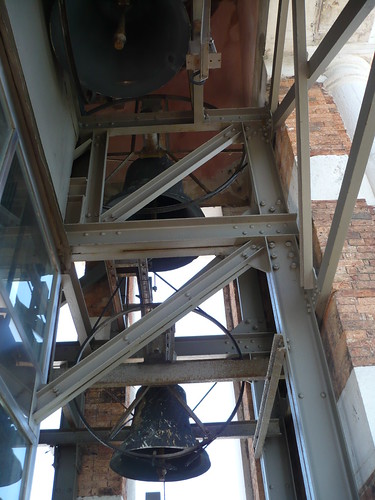In January 2011, five of my colleagues in BEAST and I founded BiLE, the Birmingham Laptop Ensemble. All of the founding members are electroacoustic composers, most of whom have at least some experience with an audio programming language, either SuperCollider or MAX. We decided that our sound would be strongest if every player took responsibility for their own sound and did his or her own audio programming. This is similar to the model used by the Huddersfield Experimental Laptop Orchestra (HELO) who describe their approach as a “Do-It-Yourself (DIY) laptop instrument design paradigm.” (Hewitt p 1 http://helo.ablelemon.co.uk/lib/exe/fetch.php/materials/helo-laptop-ensemble-incubator.pdf) Hewitt et al write that they “[embrace] a lack of hardware uniformity as a strength” and implies their software diversity is similarly a strength and grants them greater musical, (rather than technical) focus. (ibid) BiLE started with similar goals – focus on the music and empower the user, and has had similar positive results.
My inspiration, however, was largely drawn from The Hub, the first laptop band, some members of which were my teachers at Mills College in Oakland California. I saw them perform in the mid 1990s, while I was still an undergrad and had an opportunity then to speak with them about their music. I remember John Bischoff telling me that they did their own sound creation patches, although for complicated network infrastructure, like the Points of Presence Concert in 1987, Chris Brown wrote the networking code. (Cite comments from class?)
One of the first pieces in BiLE’s repertoire was a Hub piece, Stucknote by Scott Gresham Lancaster. This piece not only requires every user to create their own sound, but also has several network interactions including a shared stopwatch, sending chat messages and the sharing of gestural data for every sound. In Bischoff and Brown’s paper, the score for Stucknote is described as follows:
“Stuck Note” was designed to be easy to implement for everyone, and became a favorite of the late Hub repertoire. The basic idea was that every player can only play one “note”, meaning one continuous sound, at a time. There are only two allowable controls for changing that sound as it plays: a volume control, and an “x-factor”, which is a controller that in some way changes the timbral character or continuity of the instrument. Every player’s two controls are always available to be played remotely by any other player in the group. Players would send streams of MIDI controller messages through the hub to other players’ computer synthesizers, taking over their sounds with two simple control streams. Like in “Wheelies”, this created an ensemble situation in which all players are together shaping the whole sound of the group. An interesting social and sonic situation developed when more than one player would contest over the same controller, resulting in rapid fluctuations between the values of parameters sent by each. The sound of “Stuck Note” was a large complex drone that evolved gradually, even though it was woven from individual strands of sound that might be changing in character very rapidly. (http://crossfade.walkerart.org/brownbischoff/hub_texts/stucknote.html)
Because BiLE was a mostly inexperienced group, even the “easy to implement for everyone” Stucknote presented some serious technical hurdles. We were all able to create the sounds needed for the piece, but the networking required was a challenge. Because we have software diversity, there was no pre-existing SuperCollider Quark or MAX external to solve our networking problems. Instead, we decided to use the more generic music networking protocol Open Sound Control (OSC). I created a template for our OSC messages. In addition to the gestural data for amplitude and x-factor, specified in the score, I thought there was a lot of potential for remote method invocation and wanted a structure that could work with live coding, should that situation ever arise. I wrote a white paper (see attached) which specifies message formatting and messages for users to identify themselves on the network and advertise remotely invokable functions and shared data.
When a user first joins the network, she advertises her existence with her username, her IP address and the port she is using. Then, she asks for other users to identify themselves, so they broadcast the same kind of message. Thus, every user should be aware of every other user. However, there is currently no structure for users to quit the network. There is an assumption, instead, that the network only lasts as long as each piece. SuperCollider users, for example, tend to re-compile between pieces.
Users can also register a function on the network, specifying a OSC message that will invoke it. They advertise these functions to other users. In addition, they can share data with the network. For example, with Stucknote, everyone is sharing amplitude values such that they are controllable by anyone, including two people at the same time. The person who is using the amplitude data to control sound can be thought of as the owner of the data, however, they or anyone else can broadcast a new value for their amplitude. Typically, this kind of shared data is gestural and used to control sound creation directly. There may be cases where different users are in disagreement about the current value or packets may get lost. This does not tend to cause a problem. With gestural data, not every packet is important and packet loss is not a serious issue.
When a user puts shared data on the network, she also advertises it. Users can request to be told of all advertised data and functions. Typically, a user would request functions and shared data after asking for ids, upon joining the network. She may ask again at any time. Interested users can register as listeners of shared data. The possibility exists, (currently unused), for the owner of the data to send its value out on to registered users instead of the network as a whole.
In order to implement the network protocol, I created a SuperCollider class called NetAPI (see attached code and help file). It handles OSC communications and the infrastructure of advertising and requesting ids, shared functions and shared data. In order to handle notifications for shared data changes, I wrote a class called SharedResource. When writing the code for Stucknote, I had problems with infinite loops with change notifications. The SharedResource class has listeners and actions, but the value setting method also takes an additional argument specifying what is setting it. The setting object will not have it’s action called. So, for example, if the change came from the GUI, the SharedResource will notify all listeners except for the GUI. When SharedResources “mount” the NetAPI class, they become shared gestural data, as described above.



